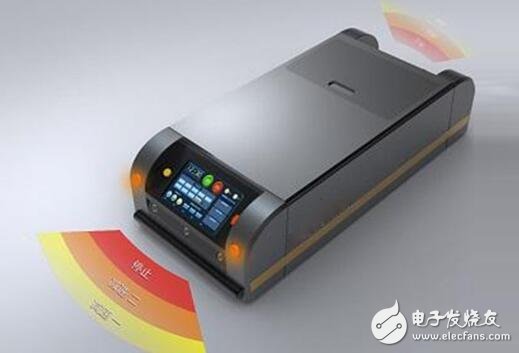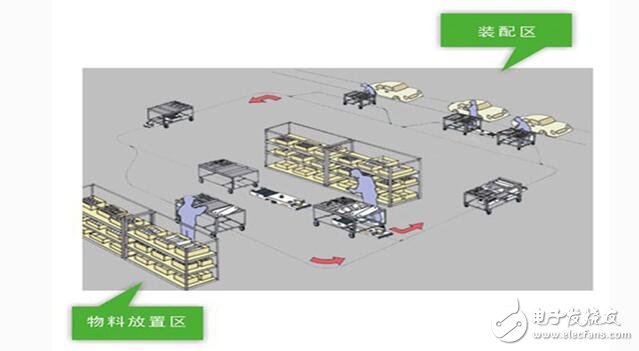Abstract: The agv car has been widely used in the industrial field, so how to achieve positioning of the agv car? This paper mainly introduces the positioning method of agv trolley, and explains in detail the application of agv trolley photosensitive device positioning method and AGV trolley automatic feeding vehicle positioning system.
The positioning principle of AGV trolleyThe magnetic material is fixed on the ground, and the magnetic sensor is fixed under the AGV body. After the magnetic sensor detects the pre-arranged magnetic strip on the ground, the detected signal is transmitted to the vehicle controller, and the vehicle controller performs the guiding calculation. And control.
AGV positioning methodIn order to ensure the accuracy and reliability of positioning, suitable sensors must be used, and different sensors form different positioning methods. There are mainly positioning methods based on photosensitive devices, positioning methods of eddy current sensors, positioning methods of photoelectric sensors, and sensor combination positioning methods.
1. Photosensor based positioning methodThe principle of this positioning method is the photoelectric effect. It is known from the light-emitting characteristics of the phototransistor that there is a good linearity between the photocurrent output and the illuminance. As the AGV keeps close to the target position, its illuminance increases, and the output of the photosensor increases, thereby controlling the positioning of the AGV. The positioning method has a long effective detection range and can reach more than 200 mm, but the positioning accuracy is low, and the output change of the photosensitive device during the whole positioning process is not obvious, which brings difficulties to the calibration.
2. Positioning method based on eddy current sensorThe eddy current sensor has a large linear measurement range and high sensitivity, and can directly measure the displacement. This positioning method enables precise positioning. The main component of the eddy current sensor is a coil, and its shape and size are related to the sensitivity and measurement range of the sensor. The detection range is generally long (100 mm or more) during positioning, and thus the volume is large. The electromagnetic field generated when the coil is operated has a magnetic influence on the coordinate guiding method and the sensor used in the electromagnetic induction guiding method.
3. Photoelectric sensor based methodThis positioning method consists of a photoelectric pair tube. Under normal circumstances, the receiving tube can receive infrared signals. When the AGV reaches the destination, the AGV blocks the infrared light and causes a control signal to be issued. This positioning accuracy can reach more than 1.5mm. If a small light gap is installed in front of the launch tube, the positioning accuracy can be increased to more than 0.6 mm. However, this positioning method cannot control the AGV after the automatic guidance ends until the final precise positioning.
4. Sensor combination positioning methodThe sensor combination positioning method consists of two parts: light guiding and fine positioning. The light guide is guided by a photosensitive device. Since the effective detection range of the photosensitive device is long, the accuracy is poor, and the precise positioning cannot be performed, and the magnetic sensor has high precision. The combined method can combine the advantages of the two. When positioning, it is guided by infrared rays to make it close to the target position, and finally fine positioning is performed by fine positioning components (such as proximity switches). This method is highly accurate, but the device is more complicated.
Positioning method of AGV trolley - photosensitive device positioning methodThe AGV trolley can automatically load and unload, and the material can be transported without driving. In the transportation process of the AGV trolley, accurately positioning the material transportation location is a very important part in the transportation process. One of the positioning methods of the AGV trolley is the positioning of the photosensitive device. law.

One of the positioning methods of the AGV trolley is based on the positioning method of the photosensitive device, and the principle is to complete the positioning of the AGV trolley by the photoelectric effect. It is known from the light-emitting characteristics of the phototransistor that there is a good linearity between the photocurrent output and the illuminance. As the AGV trolley is constantly approaching the target position, its illumination is continuously increased, and the output of the photosensor is increased, thereby controlling the positioning of the AGV trolley.

In order to ensure the accuracy and reliability of positioning, suitable sensors must be used, and different sensors form different positioning methods. The AGV trolley positioning method based on the photosensitive device can achieve an effective detection range of 200 mm or more. The disadvantage is that the positioning accuracy is low, and the output change of the photosensitive device during the entire positioning process is not obvious, which brings difficulties to the calibration.

PGA Sockets Pin Grid Array Socket
A pin grid array, often abbreviated PGA, is a type of integrated circuit packaging. In a PGA, the package is square or rectangular, and the pins are arranged in a regular array on the underside of the package. The pins are commonly spaced 2.54 mm (0.1") apart, and may or may not cover the entire underside of the package.
PGAs are often mounted on printed circuit boards using the through hole method or inserted into a socket. PGAs allow for more pins per integrated circuit than older packages, such as dual in-line package (DIP).
PGA Sockets & Adapters
Low insertion force Pin Grid Array (PGA) Sockets and Adapters are available in a variety of RoHS Compliant insulators with hundreds of screw-machined terminal choices. Virtually any PGA footprint can be accommodated, including interstitial patterns.
PGA Sockets & Adapters Overview
Durable construction for virtually any application
Wide variety of materials, lengths, and sizes
Cost-effective method for replacing, repairing, or upgrading PGA devices
Unique options such as solder preform terminals eliminate the need for wave soldering in mixed SMT/Thru-hole applications
RoHS compliant insulators and screw-machined terminals are compatible with lead-free processing - select either Matte Tin/Gold (MG) or Gold/Gold (GG) plating
Antenk's Pin Grid Array (PGA) Sockets
Complex printed circuits are too valuable to risk direct soldering to expensive integrated circuits (ICs). Using a socket is the answer. The use of sockets offers advantages that prove cost effective and simplify board design.
Antenk's processor socket line is designed for use with Intel- and AMD-based microprocessor packages. Socket types include land grid array (LGA), micro pin grid array (mPGA), and PGA with low to zero insertion force. The mPGA and PGA sockets are designed for various microprocessor packages for notebook PCs, desktop PCs, and servers. For custom applications, the compression sockets can be configured to the specific application.
mPGA/PGA (ZIF)These sockets provide a zero insertion force (ZIF) PGA interface to the microprocessor PGA package and are attached to the PCB with surface-mount technology (SMT) soldering. PGA sockets are available in arrays up to 989 positions with single lever, screw driver, and hex wrench actuation methods.
PGA Sockets (LIF)
These sockets are primarily employed for microprocessor package test applications using through-hole solder attachment to the PCB design. The contacts are screw-machine outer sleeves with either stamped and formed or drawn inner contacts. Custom arrays are available in more than 1,000 positions.
Pin Grid Array (PGA) Sockets Type
mPGA
PGA

Eliminate hand-loading of pins, facilitate solder joint visibility, low profile component mounting or board mating.
PGA Sockets,mPGA Sockets,Integrated Circuits Socket,Pin Pga Sockets,Pga Socket Connector,PGA Adapters,Pin Grid Array Sockets,Processor Socket
ShenZhen Antenk Electronics Co,Ltd , https://www.pcbsocket.com